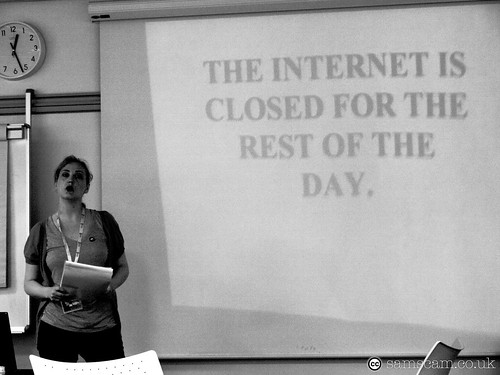I’ve been talking to a lot of teachers lately about copyright, Creative Commons and how we might deal with the issues that arise when we want to use other peoples’ images and media and remix them into something new and creative. The restrictive thinking of traditional copyright has become an anachronism in the digital age. It just doesn’t serve us well any more.
The example I’ve been citing is the one I heard Larry Lessig mention, and that’s the story of how when land owners were once given title to their land, the title of ownership used to be phrased in language that essentially said they owned not only the parcel of land, but all the ground below it to the center of the earth and all the sky above it to the heavens. It was a nice romantic concept, this idea that you owned not just the surface of the land but the infinite column of space that extended above it.
Well, it was a nice romantic concept until the airplane was invented, that is. As more aircraft started to appear in our skies a number of greedy land owners started to make demands for payment to allow these aircraft to pass through “their” space, which they technically owned. The point is that the original land titles which gave them ownership of this space above their land were drafted in a time when the idea of travelling through the space was unimaginable. It was simply not a problem that anybody envisioned and so the laws were written in a way that did not take account of the possibility. As aircraft took to the skies, the laws had to be changed to allow for it… for to not adapt the old, outdated laws would have completely stifled the development of flight. Put simply, the old laws no longer made sense – the airplane caused a complete rethink of how these laws should work.
It easy to see the parallels with copyright law in the digital age. Many of our copyright laws were written in a time when the implications of the digital age were equally unimaginable. Copyright law is not written with the notion that creative works could be infinitely reproducible and easily mashed together to form new creative works, and that digital convergence allows all media types to be easily brought together and combined, edited and remixed in new ways. Copyright law was written in a time that never imagined that the price and power of computing devices would drop to the point that they could be used to make artwork, create music, edit movies and build media that would have required highly specialised equipment and thousands of dollars only a few short years ago, so that the barrier to entry is such that anyone who wants to create can produce professional looking work with limited resources. Finally, consider that not only has the cost of making media dropped to virtually nothing, but the cost of distribution of that media has also dropped to almost nothing… consider that a creative kid sitting in their bedroom can now use a computer and their own creativity to make a video and distribute it to a global audience of millions at essentially no cost. This is not the world that copyright was written for.
Creativity has always been built on the work of others. Our great artists, musicians and film makers have always stood on the shoulders of the giants that came before them, building on their ideas and extending them into new areas. Very little creative work comes from a foundation of nothing… it nearly always uses, references or extends upon the work of others. Manet influenced Monet, who influenced Renoir, who influenced Gauguin, who influenced Picasso, who influenced Duchamp, and so on. Some of the greatest creative minds in history were great because they built on the ideas of those who came before them, adding to them and creating yet more new ideas because of it. We have always been a remix society.
I have no idea what the long term answer is to all this but I do know that we need to find one. Creative Commons goes some way towards providing a balance between protecting the intellectual property rights of the creator and allowing some reasonable use of their work for remixing and recreating. It provides some common sense to an area where it often seems to be lacking.
This video is a great example of what can be done when someone wants to be creative with the work of someone else… the song, Again and Again by The Bird and The Bee, is borrowed to provide a soundtrack for an amazing piece of visual work that is creative in it’s own right. Created with nothing more than a Macintosh computer and an amazing degree of creativity, the video has been viewed nearly a million times on YouTube.

 I have on occasion been frustrated – dare I say critical – of the sometimes glacial pace of change in the broader educational community when it comes to embracing the use of ICT. I occasionally say things that might make me appear less compassionate than I really am. But believe it or not, I really do have a great degree of patience and time for anyone who is genuinely interested to know more about how to effectively integrate technology into the demanding job of teaching kids every day.
I have on occasion been frustrated – dare I say critical – of the sometimes glacial pace of change in the broader educational community when it comes to embracing the use of ICT. I occasionally say things that might make me appear less compassionate than I really am. But believe it or not, I really do have a great degree of patience and time for anyone who is genuinely interested to know more about how to effectively integrate technology into the demanding job of teaching kids every day. I started thinking about this when I read about the recent passing of Olive Riley, a 108 year old woman who regularly wrote on her Blogger account and was known as the
I started thinking about this when I read about the recent passing of Olive Riley, a 108 year old woman who regularly wrote on her Blogger account and was known as the  But that was not my first foray into going online. It was maybe a year prior to that that I’d discovered
But that was not my first foray into going online. It was maybe a year prior to that that I’d discovered